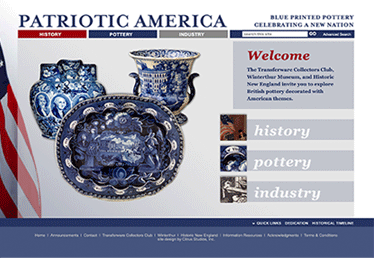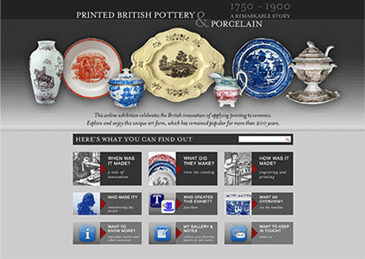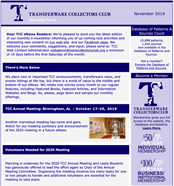


Videos made available here are from two vital resources:
The Transferware Worldwide Lecture Series - free quarterly Zoom lectures open to all. These lectures are recorded and made available to current TCC members after the Zoom session. Member login required.
Recorded presentations during TCC Annual Meetings and Conferences, including lectures presented during the 2025 TCC Hartford, Ct. Conference, which celebrated the many "Landscapes, Real and Imagined, on British Transferware!”. The meetings have been videotaped and added to the TCC website for members to view with login.
Other Films and Videos, featuring a variety of lectures, presentations, and videos, available to TCC members and site visitors. Thanks to Phil Rowley of the Facebook site Potteries of Stoke on Trent for identifying many of the presentations, available on YouTube and initially presented at the Gladstone Museum. These presentations are supplemented by suggestions from other individuals. If you have a recommendation, contact the TCC Web Administrator.
Transferware Worldwide Lecture Series ANNUAL MEETING & CONFERENCE LECTURES Other Films and Videos
Login or Become a Member
to view this video.
Speaker: Heeryoon Shin, Assistant Professor of Art History and Visual Culture, Bard College
Description: Nineteenth-century India, blue-and-white transferware from Staffordshire found a new life as affixed ornamentation in palace interiors. Set into walls in original form, or broken into flat, rectilinear pieces to meticulously cover walls, niches, and balconies, British transferware plates and their luminous blue-and-white surface effectively framed gods and kings and created a multisensory experience of space. Taking the two late nineteenth-century sites of Juna Mahal in Dungarpur and Junagadh Fort in Bikaner as points of departure, she explores how the design and materiality of British transferware as well as their display acquired new meaning and purpose in Indian palace spaces. Evoking the tradition of tiled ornamentation and the display of ceramics in the chini khana (“China room”) in India, while also referencing European porcelain rooms, the transferware-covered walls reveal the complex cultural negotiations and material and political aspirations of nineteenth-century India. By examining the Indian reuse of British transferware, this talk complicates the conventional narrative of West looking East and highlights the nonlinear and multidirectional flows of ceramic culture.
Speaker: Heeryoon Shin, Assistant Professor of Art History and Visual Culture, Bard College. Heeryoon Shin is Assistant Professor of Art History and Visual Culture at Bard College, New York. Her current project explores architectural revival, mobility, and cross-cultural exchange in early colonial India through the lens of temple architecture in the pilgrimage city of Banaras. She is also developing a second project on the global circulation of blue and white ceramics and their interaction with local production and use in South Asia.
Login or Become a Member
to view this video.
Speaker: Bradley Brooks, Curator, Bayou Bend Collection Museum of Fine Arts, Houston
Description: Ima Hogg (1882-1975), daughter of James Stephen Hogg, the first native-born governor of Texas, lived for a time in the Texas governor's mansion in Austin. The experience helped shape her appreciation for both antiques and history. In the early 1920s, she began to collect American antiques, including glass, ceramics, and furniture. Later in the decade, she embarked on the construction of Bayou Bend in Houston, which would be her home until the 1960s. As her collection grew, Miss Hogg resolved that she would establish a museum. She made gifts of her home and collection to the Museum of Fine Arts, Houston; Bayou Bend opened to the public in 1966. This presentation explores Miss Hogg's interest in transfer-printed ceramics, with emphasis on the Texian Campaigne pattern.
Login or Become a Member
to view this video.
Speaker: Pat Halfpenny, Curator Emerita, Ceramics & Glass, Winterthur Museum
Description: Pat’s presentation discussed the scenes of Philadelphia found on printed pottery and the Staffordshire manufacturers who produced them. While the focus was on the dark blue prints of the 1820s, there were references to later Romantic Staffordshire with Philadelphia themes, concluding with a brief look at polychrome printed pieces.
Login or Become a Member
to view this video.
Lecturers: Nick Routson and Ceramic Specialist Heather Cline in a discussion/presentation moderated by Leslie Bouterie
Description: In this program, guest presenters TCC Member and Transferware Collector Extraordinaire Nick Routson and TCC Secretary, Ceramic Specialist, and Auction House Professional Heather Cline will share the “ins and outs” of the auction process from two points of view: that of the collector-seller and that of the auction house sales team. In 2021, Nick Routson embarked on a monumental downsizing of his stellar and extensive collection of American Historical transferware along with much of his lovingly assembled collection of antique furniture, textiles, ceramics, and glass from his home in Phoenix, Arizona. He selected the prestigious auction house of Jeffrey S. Evans and Associates of Mt. Crawford, Virginia, to handle the multi-session sale. Nick worked closely with their Head of Ceramics Heather Cline on all aspects of the process. In a lively discussion, moderated by Leslie Lambour Bouterie, Nick will share his personal experiences of preparing and placing his treasures in the capable hands of the auction house professionals over 2,000 miles away, and Heather will explain the process of expertly accessioning, promoting, and selling his beautiful antiques. With their insights shared and Q & A opportunities offered, the “mysteries” of the auction process will be revealed.
Rich with content for ceramic collectors, researchers, authors, curators, and historic archaeologists, the sites are sure to deliver value for their visitors. The exhibition’s curators continue to enhance them and, now, with site application upgrades, including a new magnification feature and upgraded content management capabilities, the TCC and its collaborators are pleased to relaunch these exhibits, all free to a worldwide audience.

Branded Patriotic America, debuted in 2014 in collaboration with Historic New England, and the Winterthur Museum

Launched in 2015 in partnership with the Northern Ceramic Society.
 Not a member but want to receive email updates?
Not a member but want to receive email updates?